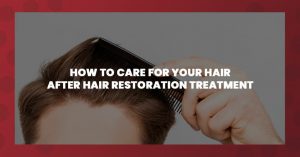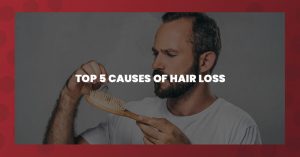androgenic alopecia – also known as male pattern baldness – is the most common form of male hair loss… impacting up to half of American men by the age of 50. Sparked by one’s genes and fueled by hormones, it impacts all phases of hair growth and results in a distinctive pattern of hair loss.
What causes androgenic alopecia, and can anything be done to prevent or reverse it? Let’s take a look at these frequently asked questions.
What Does Androgenic Alopecia Look Like?
Male pattern hair loss typically begins with receding hair at the temples. This is followed by thinning of the hair on the crown of the scalp, which creates an “M” shaped hairline. These two areas of hair loss eventually join together… leading to baldness on top of the scalp and (occasionally) to complete baldness.
Men with androgenic alopecia have a shorter hair growth (anagen) phase and a longer resting (telogen) phase. This ultimately results in shorter hairs that fail to emerge from the follicles.
Many women also experience androgenic alopecia but rarely have complete hair loss. The female hairline tends to remain intact while hair gradually thins over the entire scalp. The first sign of female pattern hair loss is usually a widening of the central part or a smaller ponytail.
What Are the Causes of Androgenic Alopecia?
Although there is debate over which specific gene causes it, androgenic alopecia is a hereditary condition. Studies disagree on whether it is passed through one’s father or mother, and there is mounting evidence that it may be a combination of genetic traits from both sides of one’s family.
The condition is directly linked to the male hormone dihydrotestosterone (DHT), the most abundant androgen (male sex hormone) in one’s skin. Over time, androgens reduce the size of hair follicles on the head and disrupt the hair growth cycle. Interestingly, they do not have the same impact on hair follicles elsewhere on the body and can actually promote positive growth of chest, groin, and beard hair.
Can Androgenic Alopecia Be Reversed?
Recent years have brought many advances in treatment for male pattern baldness. An array of surgical and non-surgical androgenic alopecia treatments can slow down – or even reverse – some degree of hair loss.
FDA-approved medications like minoxidil or finasteride can help regrow hair and preserve existing hair. These are often used in conjunction with other types of treatment to give you the best results.
Minoxidil began as an oral medication for hypertension. When it was discovered that excess hair growth was a side effect, it was developed first as an oral and then a topical medication to promote hair growth. It is frequently used as a topical solution or foam to aid in boosting follicular health during the hair’s growth phase. Studies show that topical minoxidil is safe and effective if used consistently. If use is discontinued, hair loss will resume, and the benefits will be lost.
Finasteride is an oral medication that inhibits an enzyme that converts testosterone to DHT, thereby reducing DHT levels in the scalp. It has a high success rate in maintaining hair growth and (like minoxidil) must be taken continuously to maintain its benefits.
Other non-surgical treatments for androgenic alopecia include platelet-rich plasma injections to sustain hair growth, exosome injections to stimulate new hair growth, and in-office or at-home low-level laser therapy treatments to stimulate hair follicles.
Living a healthy lifestyle, especially consuming a hair-friendly diet, is a crucial piece of your hair-health puzzle. A balanced-nutrition, anti-inflammatory, antioxidant-rich diet with adequate proteins will provide your body and scalp with optimal conditions for healthy hair growth. Maintaining good health and reducing stress may help prevent additional hair loss in some cases but – unless the hair loss is caused by a nutrient deficiency – diet will not reverse hair loss.
If your hair loss has progressed significantly, surgical replacement can give permanent, natural-looking results. Manual and state-of-the-art robotic-assisted follicular unit excision can restore your hairline with minimal downtime.
Set Up A Consultation With The Hair Center Of Nebraska
If you are experiencing male pattern hair loss, contact the Hair Center of Nebraska for a full hair and scalp analysis. We’ll evaluate to determine the cause of your hair loss and guide you in selecting the treatment plan that is best for you. By setting up a consultation, you are taking the first step on your journey to a better life. Contact us today to set up an appointment.






